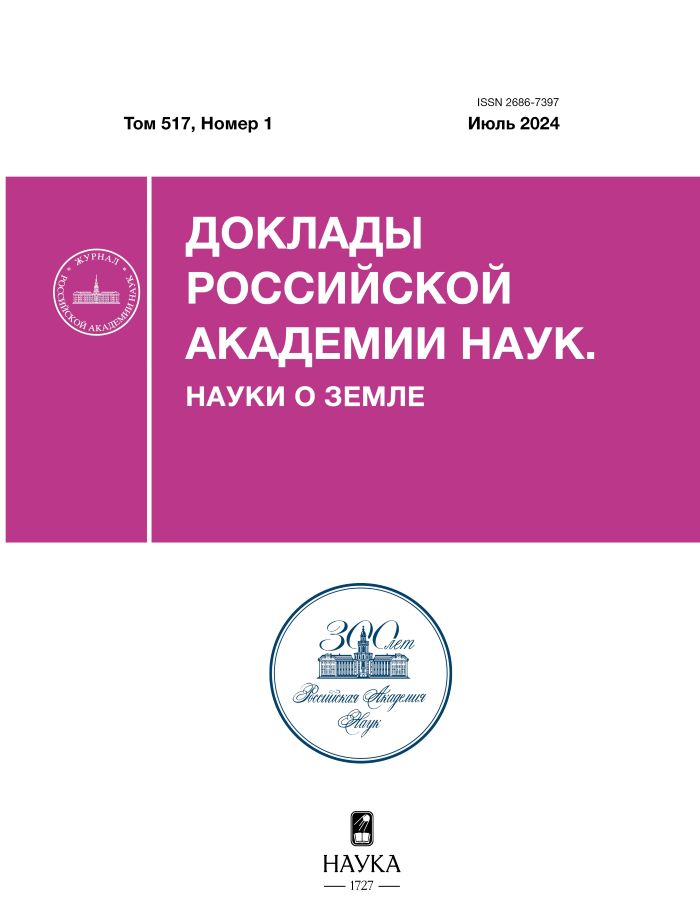Inclusion of kokchetavite in a diamond crystal from Venezuela: an evidence of continental crust subduction
- 作者: Korsakov A.V.1, Mikhailenko D.S.1,2, Serebryannikov A.O.1, Logvinova A.M.1, Gladkochub D.P.3
-
隶属关系:
- Sobolev Institute of Geology and Mineralogy, Russian Academy of Sciences
- Zavaritsky Institute of Geology and Geochemistry, Ural Branch of the Russian Academy of Sciences
- Institute of the Earth's Crust, Siberian Branch of the Russian Academy of Sciences
- 期: 卷 517, 编号 1 (2024)
- 页面: 134-142
- 栏目: GEODYNAMICS
- ##submission.dateSubmitted##: 31.01.2025
- ##submission.datePublished##: 13.12.2024
- URL: https://ter-arkhiv.ru/2686-7397/article/view/650009
- DOI: https://doi.org/10.31857/S2686739724070141
- ID: 650009
如何引用文章
详细
We have examined in detail diamond crystals from the Guanyamo placer deposit (Venezuela) with numerous mineral inclusions. Inclusions in the studied diamonds are represented by a typical set of eclogite-paragenesis indicator minerals: omphacite, garnet, kyanite, coesite and rutile. In addition to single mineral inclusions, polyphaser inclusions have also been diagnosed. The mineral associations of polyphase inclusions adjacent to each other within a distance of less than 100 micrometres within the same growth zone can vary significantly. For example, in one of the diamond crystals studied, polyphase inclusions are represented by the following associations: sanidine – dolomite – anatase and magnetite – rutile – dolomite – apatite – kokchetavite – graphite. It should be noted that this is the first discovery of kokchetavite as an inclusion in diamond crystals of kimberlite origin. Previously, this hexagonal polymorphic modification of KAlSi3O8 had only been diagnosed in minerals from continental crustal rocks formed under conditions of high or ultra-high mafic metamorphism. Thus, the presence of kokchetavite as inclusions in diamond crystals carried by kimberlites allows us to infer the subduction of continental crustal material to mantle depths and its important role in metasomatic alteration of upper mantle rocks.
全文:
作者简介
A. Korsakov
Sobolev Institute of Geology and Mineralogy, Russian Academy of Sciences
Email: pazilovdenis@igm.nsc.ru
俄罗斯联邦, Novosibirsk
D. Mikhailenko
Sobolev Institute of Geology and Mineralogy, Russian Academy of Sciences; Zavaritsky Institute of Geology and Geochemistry, Ural Branch of the Russian Academy of Sciences
编辑信件的主要联系方式.
Email: pazilovdenis@igm.nsc.ru
俄罗斯联邦, Novosibirsk; Ekaterinburg
A. Serebryannikov
Sobolev Institute of Geology and Mineralogy, Russian Academy of Sciences
Email: pazilovdenis@igm.nsc.ru
俄罗斯联邦, Novosibirsk
A. Logvinova
Sobolev Institute of Geology and Mineralogy, Russian Academy of Sciences
Email: pazilovdenis@igm.nsc.ru
俄罗斯联邦, Novosibirsk
D. Gladkochub
Institute of the Earth's Crust, Siberian Branch of the Russian Academy of Sciences
Email: pazilovdenis@igm.nsc.ru
Corresponding Member of the RAS
俄罗斯联邦, Irkutsk参考
- Михайленко Д. С. и др. Находка коэсита в алмазоносном кианитовом эклогите из кимберлитовой трубки Удачная (Сибирский кратон) // ДАН. 2019. Т. 48. № 4. P. 428–431.
- Соболев Н. В. Коэсит как индикатор сверхвысоких давлений в континентальной литосфере // Геология и геофизика. 2006. Т. 47. № 1. P. 95–104.
- Jacob D. E. Nature and origin of eclogite xenoliths from kimberlites // Lithos. 2004. V. 77. № 1. P. 295–316.
- Sobolev N .V. et al. Unusual upper mantle beneath Guaniamo, Guyana shield, Venezuela: Evidence from diamond inclusions // Geology. 1998. V. 26. № 11. P. 971–974.
- Hwang S.-L. et al. Kokchetavite: a new potassium-feldspar polymorph from the Kokchetav ultrahigh-pressure terrane // Contrib Mineral Petrol. 2004. V. 148. № 3. P. 380–389.
- Mikhno A. O., Schmidt U., Korsakov A. V. Origin of K-cymrite and kokchetavite in the polyphase mineral inclusions from Kokchetav UHP calc-silicate rocks: evidence from confocal Raman imaging // European Journal of Mineralogy. 2013. V. 25. № 5. P. 807–816.
- Borghi A. et al. The role of continental subduction in mantle metasomatism and carbon recycling revealed by melt inclusions in UHP eclogites // Science Advances. 2023. V. 9. № 11.
- Romanenko A. V. et al. Compressibility and pressure-induced structural evolution of kokchetavite, hexagonal polymorph of KAlSi3O8, by single-crystal X-ray diffraction // American Mineralogist. 2024. (in press).
- Kaminsky F. V. et al. Diamond from the Guaniamo area Venezuela // The Canadian Mineralogist. 2000. V. 38. № 6. P. 1347–1370.
- Hardman M. F. et al. Characterising the Distinct Crustal Protoliths of Roberts Victor Type I and II Eclogites // Journal of Petrology. 2021. V. 62. № 12. P. egab090.
- Sobolev N. V., Shatsky V. S. Diamond inclusions in garnets from metamorphic rocks: a new environment for diamond formation // Nature. 1990. V. 343. P. 742–746.
- Hermann J. et al. Aqueous fluids and hydrous melts in high-pressure and ultra-high pressure rocks: Implications for element transfer in subduction zones // Lithos. 2006. V. 92. P. 399–417.
- Korsakov A. V., Theunissen K., Smirnova L. V. Intergranular diamonds derived from partial melting of crustal rocks at ultrahigh-pressure metamorphic conditions // Terra Nova. 2004. V. 16. P. 146–151.
- Korsakov A. V., Hermann J. Silicate and carbonate melt inclusions associated with diamonds in deeply subducted carbonate rocks // Earth and Planetary Science Letters. 2006. V. 241. № 1. P. 104–118.
- Kaminsky F. V. et al. Diamond from the Los Coquitos Area, Bolivar State, Venezuela // The Canadian Mineralogist. 2006. V. 44. № 2. P. 323–340.
- De Corte K. et al. Diamond growth during ultrahigh-pressure metamorphism of the Kokchetav massif, northern Kazakhstan // The Island Arc. 2000. V. 9. P. 284–303.
- Cartigny P. et al. The origin and formation of metamorphic microdiamonds from the Kokchetav massif, Kazakhstan: a nitrogen and carbon isotopic study // Chemical Geology. 2001. V. 176. № 1–4. P. 265–281.
- Schulze D. J. et al. Extreme crustal oxygen isotope signatures preserved in coesite in diamond //Nature. 2003. V. 423. № 6935. – P. 68–70.
- Channer D. M. D., Egorov A., Kaminsky F. Geology and structure of the Guaniamo diamondiferous kimberlite sheets, south-west Venezuela // RBG. 2001. V. 31. № 4. P. 615–630.
- Schulze D. J. et al. Layered mantle structure beneath the western Guyana Shield, Venezuela: Evidence from diamonds and xenocrysts in Guaniamo kimberlites // Geochimica et Cosmochimica Acta. 2006. V. 70. № 1. P. 192–205.
补充文件














